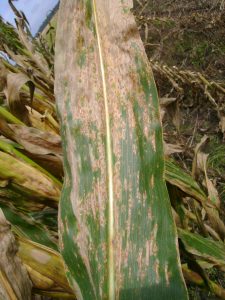With recent hail in Illinois, the questions will start coming in as to the utility of foliar fungicides for wounded plant tissues. Some people consider fungicides for hail-damaged crops because it is believed that hail can either increase infection of fungal pathogens or increase plant stress and foliar disease. Furthermore some claim that potential physiological effects of some fungicidal active ingredients allow for plants to recover more quickly from hail damage and limit potential yield losses. It is important to note that the fungi that infect field crops do not require wounds to infect and cause disease. It is also important to note that bacterial diseases such as Goss’s wilt and bacterial leaf streak, which potentially could increase with hail damage, will not be controlled by fungicides.
What does the research say? Research from the University of Illinois was conducted on this subject over a two year period. Simulated hail damage (via string mowers) was applied at the at the V12 stage followed by applications of foliar fungicides. Overall, the study showed that the fungicides did not provide any yield benefit to hail-damaged corn. A link to the study can be found here.
A study at the University of Wisconsin examined different corn hybids and fungicides for their reaction to anthracnose. During the course of the study hail naturally damaged the corn in the trial. Although the hail did reduce yields, fungicides did not improve plant health or result in improved yields. A soybean trial that was conducted at the same time and also damaged by hail showed no differences between fungicide treated plots vs. untreated controls. A write-up of these studies can be found here.
Other research looking at timing of hail damage to corn and soybean and various pesticides was conducted by researchers at Iowa State. Results of their studies indicate that hail damage to soybean at R4 caused less yield loss than hail damage at R1. In corn, hail damage at R2 caused more yield loss than hail damage at VT. Fungicide application, either immediately following injury or applied several days afterwards, did not have an effect on yield. These studies can be accessed here.
Fungicides are effective at controlling fungal diseases and their benefits are realized when used in situations where fungal diseases are likely to limit crop productivity. They will not help with bacterial diseases, such as Goss’ wilt, bacterial stalk rot, or bacterial leaf streak. The current studies indicate that the application of fungicides for mitigation of hail damage does not appear to significantly improve yields over untreated controls. If you do choose to apply a fungicide to hail damaged crops this year, consider leaving an untreated strip in the field to allow for a comparison of treatment effectiveness at the end of the growing season.


